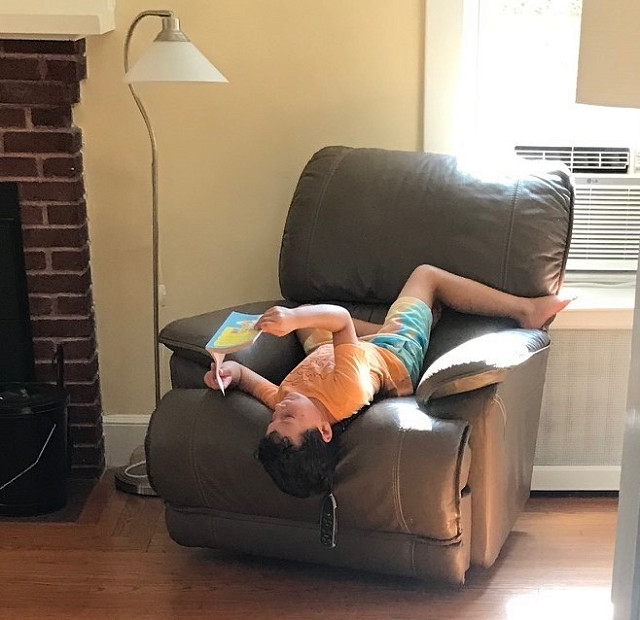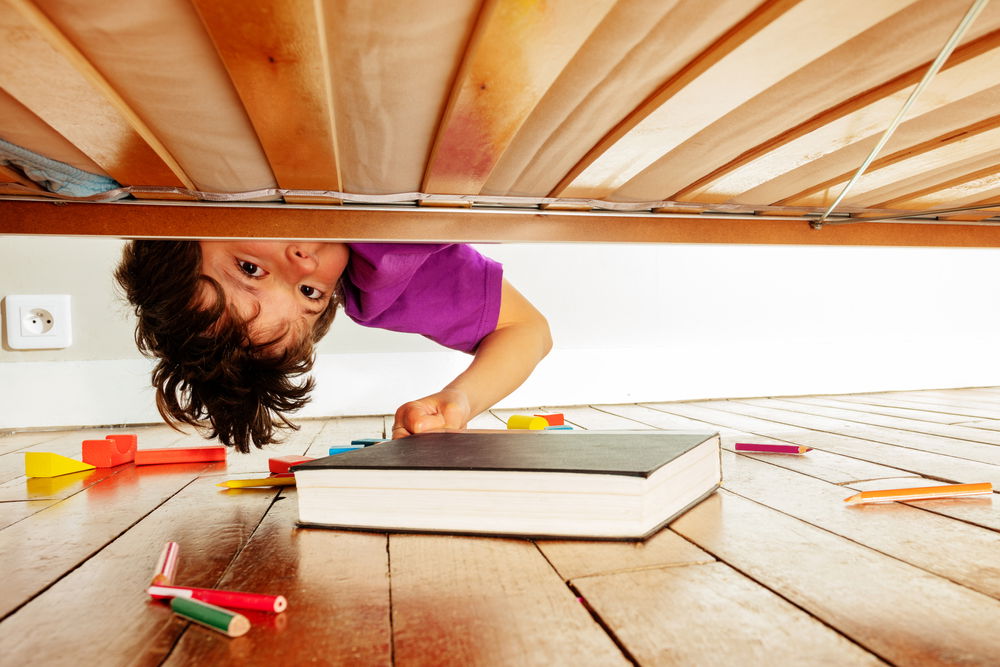Highlights
- One benefit of homeschooling is the ability to tailor teaching to a child’s individual learning style—including that of an active little boy. Post This
- Once I got over my preconceived notions of what learning should look like, I was delighted to watch my son blossom both academically and emotionally. Post This
- Boys don’t lag in their ability to comprehend—rather, they lag in their ability to stay seated at a desk. Post This
In September 2020, my oldest son started kindergarten at our local public school. Due to COVID, there were a lot of new rules. The desks were moved apart, and all the kids wore masks inside. There was no more cozy reading circled up with the teacher and classmates on the carpet. There was still outside recess, but the children were not allowed to touch each other. Without faulting my son’s kindergarten teacher—who was doing the best she could under difficult circumstances—it became clear that this environment was profoundly difficult for my five-year old. He loved preschool (before it was shut in March 2020), but kindergarten was a different story. During a virtual parent-teacher conference, we were told he was having trouble sitting at his desk, so he was being sent out for walks with a paraprofessional. I worried as I watched my previously happy, energetic little boy withdraw into himself.
We pulled him from the public school when his kindergarten year was over and enrolled him at a nearby parochial school for first grade. In second grade, we decided to homeschool him. I quickly realized that he both loved to learn and to move. He completed worksheets on the floor, read upside down on the couch, and asked to run outside to jump rope before starting a math lesson. I had gone to public school from kindergarten to 12th grade, and this was strange to me. Learning, as I understood it, happened at a desk. But once I got over my preconceived notions of what learning should look like, I was delighted to watch him blossom both academically and emotionally.
Recently, I wondered about the experiences of other homeschooling parents of young boys and whether they have noticed their boys thriving with the freedom to move around more. The answer is a resounding yes. I heard stories about little boys learning while jumping on trampolines, coloring while listening to “read alouds” in order to “get the energy out,” and learning best when school happened outside. One mother sent me a photo of her son answering math questions upside down on the couch—a pose familiar to me from homeschooling my own son!

Photo of the author’s oldest son, working on a reading assignment.
This is not, of course, to say that girls don’t also benefit from lots of physical and outside activity while learning, but I haven’t yet homeschooled a girl (my daughter is still a baby).
To draw on the wisdom of someone with much more homeschooling experience than myself, I interviewed Faith Hough on this topic. Faith is a homeschooling mother of eight, who was also homeschooled herself until college. At Franciscan University, she studied Spanish and early childhood development, and did several stints as a student teacher. I asked her whether one benefit of homeschooling was the ability to tailor teaching to a child’s individual learning style—including that of an active little boy. I wondered, could homeschooling allow students with a non-standard learning style to succeed?
“After having been in schools,” she told me, “I think it’s almost a myth that there is a child that has a standard learning style. But I think a lot of children can learn to adapt to the teaching style that’s in school.” While many children “might benefit from a different learning style,” Faith added, “they’re able to sort of roll with whatever they’re given.” But, in addition to these adaptable children who can easily adjust to different teachers, “there are kids who can’t, or won’t, or just don’t.” These children, Faith emphasized, “…struggle with anything [where] there’s a focus on sitting still,” rather than on learning.
This rang true to me. It is no secret that boys have been falling behind girls in school for years. Earlier this month, the American Psychological Association released a report by its Task Force on Boys in School. The report found: “At school, by almost every metric, boys of all ages are doing worse than girls.” It noted boys “are disciplined and diagnosed with learning disabilities at higher rates, their grades and test scores are lower, and they’re less likely to graduate from high school.”
Indeed, the challenges faced by boys in school are so serious that Richard Reeves, a senior fellow at Brookings, has proposed delaying boys’ entry to kindergarten by a year. This process, sometimes called “redshirting,” has become increasingly common. Waiting until boys are older to enroll them in kindergarten is beneficial, according to Reeves, because “boys mature later than girls.”
Is part of the problem faced by boys not precisely maturity, but rather the inability of most schools to accommodate little boys’ need to run, skip, and climb? As Faith points out, many of these wiggly children are equally able to learn, including by tackling complex subjects. They don’t lag in their ability to comprehend—rather, they lag in their ability to stay seated at a desk.
According to Dr. Leonard Sax, a family physician who wrote Why Gender Matters:
How long can you sit still, be quiet, and pay attention? We find no difference on that parameter comparing a 40-year-old woman with a 40-year-old man. But when we compare a 6-year-old girl with a 6-year-old boy, we find that the average 6-year-old boy can sit still, be quiet, and pay attention for only about half as long as the average 6-year-old girl. He may be sitting still and being quiet, but he is not paying attention. It’s common to find 6-year-old boys who absolutely have to stand and make buzzing noises in order to learn. It’s unusual to find a 40-year-old man who absolutely has to stand and make buzzing noises in order to learn.
As Dr. Sax has written in this space, a “boy friendly” school “offers at least three recesses per day, and kids are allowed to play Tag during recess.”
In an email, Dr. Sax told me that my 7-year-old son’s need to move around while learning is not unusual. “[M]any 7-year-old boys learn better when they are moving around,” he said, adding that the same is true for some girls.
“One size does not fit all,” he noted. Indeed, he expressed some skepticism of the value of the traditional classroom environment for all children. “I sometimes wonder whether we require kids to sit in chairs in school, not because it is the best possible learning environment, but because it’s the easiest way to manage a classroom,” Dr. Sax said. “One advantage of homeschooling is that the parent can customize the educational experience to the child.”
What would a homeschooled education tailored specifically to the needs of active little boys look like?
To answer this question, I spoke with Melissa Heise, who has five children, including four boys. After graduating from public school, Melissa received a master’s and bachelor’s degree in chemical engineering, and her oldest boys are in third and first grade. While candid that homeschooling is “harder” than she expected, Melissa believes it’s a good fit for her family. She particularly appreciates being able to give her boys a chance to show what they’ve learned orally, rather than in writing.
“In a school, you have to write down most of everything you want to prove that you have learned, and with boys the act of writing is … another step,” she explained. “It’s different from proving that they know their addition and subtraction facts…it’s another barrier.” Her children also finish homeschooling in a shorter period of time than traditional school, since she’s able to offer one-on-one time to each child. With this flexibility, she aims for two hours of daily outside playtime for her children. By contrast, most states have no recess requirements at all—and of those that do, many mandate only 20 minutes.
When I compared Melissa’s two hours of daily recess with my oldest child’s school recess during COVID, my heart sank a little. I went to ask him about it. He was reading a comic book, slumped down on a dining room chair, his feet up on the table (which I’ve fruitlessly told him to stop doing many times). I asked him what they did at recess, since he couldn’t play tag and they were mostly supposed to stay apart. Anyone with a little boy will recognize the answer I got: “I dunno,” he muttered, not looking up from his book. “Sounds like not much fun,” I said. His face looked grim, and he sank further down into his chair: “It wasn’t.”
To be sure, schooling during the pandemic was a special circumstance. Still, to what extent are so many little boys struggling in traditional schools because they’re cut off from their natural need to run around outside playing tag, and instead forced to sit for hours at desks doing worksheets?
Ivana D. Greco is the Wollstonecraft Fellow at the Abigail Adams Institute. She is currently drafting a book investigating the myriad ways stay-at-home parents are integral to American society, business, and government.















